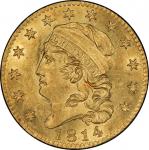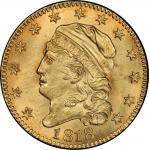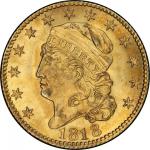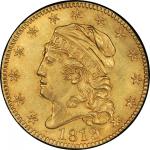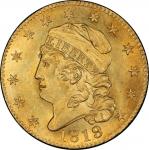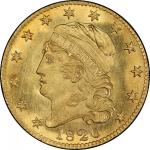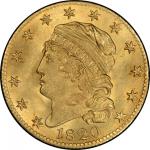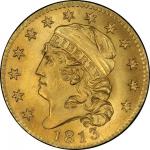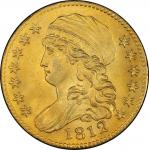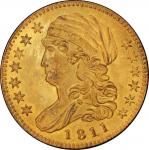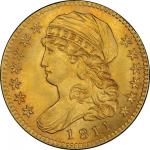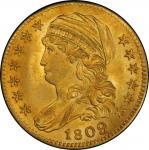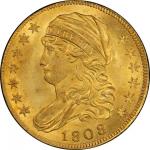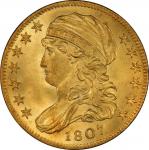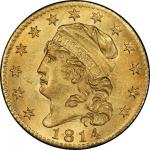“Sit on the spacious front porch of the home of John Zug, at Bowie, and you will have a man for a companion that knows coins and is eager to talk about them in a way that leaves an indelible impression on the mind that enhances one’s outlook on life and increases his general knowledge of the coins of all times and all ages.“ — Robert K. Botsford, The Numismatist, July 1933 The 1814/3 overdate is one of the most fascinating dates in the Capped Bust half eagle series. Nearly always found with heavy distinctive clash marks, its overdate visible under low magnification, this is a popular rarity. This choice example ranks among the finest known and is thus of the greatest importance to students of the series. The cartwheel luster is profound, a bit more satiny on the reverse than obverse but no less bright. Choice medium yellow gold surfaces develop some coppery toning as they near the right obverse periphery. Only minor marks and subtle hairlines are seen, including a tiny nick in the field near Liberty’s lips and a shallow abrasion under the first A of AMERICA. The strike is surprisingly full, given what these dies have been through, showing softness just on the highest relief portions of Liberty’s portrait and among the denticles of the upper right obverse. The typically encountered clash marks are particularly bold here, with an impression of the reverse shield barely hidden among the details above and behind Liberty’s ear. Clash marks loom in the obverse fields near Liberty’s mouth and forecurl, between her hair and star 12, and above the date. The clash marks around stars 7 and 8 and subsequent attempts to lap them away have altered the look of several denticles atop the obverse, and some heavy vertical lapping lines remain beneath star 10 from the effort to remove a pit on the die face in that area. A light die crack from the bottom of 4 trails off in the field closer to star 13, where it encounters more lapping lines. On the reverse, the peripheral die cracks are in much the same positions as they were on the 1813 BD-2 offered above. The delicate crack that connected the tops of CA of AMERICA is now gone, a casualty of the lapping that followed the die clash. Remnants of the clashing persist above the denomination and among the arrowheads, above the wing at left, and beneath IBU and M of E PLURIBUS UNUM. Some microscopic spalling at the tips of the olive leaves and UN of UNITED has developed since the 1813 BD-2 marriage. Though his name is little known today, John Zug was among the most familiar names in numismatics in the era of the 1920s through 1940s. His large advertisements were seen in nearly every issue of The Numismatist over this time span; his inventory was thought to be among the largest in the country. Zug was a major wholesale dealer in modern issues of the era, and his retail operation included advertisements in newsstand monthlies like Popular Mechanics. Zug and fellow Washington-area dealer Charles Kohen, who counted President Franklin D. Roosevelt and Henry Ford among his clients, together ran the 1937 American Numismatic Association convention auction. While buying and selling coins that were then quite common, like silver dollars and commemorative half dollars, Zug built a significant private collection that was not sold until after his death. This treasured half eagle was among the pieces he set aside, breaking his usual cycle of buying and selling. It has sold just once at auction since his estate was auctioned. While a significant percentage of surviving 1814/3 half eagles is in relatively high grade, with the largest cluster of survivors graded in the About Uncirculated range, no gems have ever been certified. Typical specimens show significant adjustment lines, an array of fine contact marks, and high point friction. This example, a candidate for finest known honors, shows none of these aspects. Just four examples have ever been graded finer than MS-63 by PCGS, with this example alone atop the population report. Nearly seven years have passed since the sole appearance of a PCGS MS-64 at auction. This example was last offered publicly a quarter century ago. PCGS# 519908. NGC ID: 25PN.

